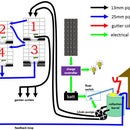Introduction: Upgrading the Exterior Lights on a Landrover Defender to NAS. (Part 1 of 3)
I decided that I liked the idea of lights on my 1990 landrover defender county which were easier to maintain and gave out a better light than the originals.
This instructable shows how I went about it. This is step 1 of 3 which mainly deals with the electrical fittings.
Step 1: Bits/tools Required
Part Number Description
320.RF7. 12/24v Rear Fog Lamp with straight connector
320.SL9. 12/24v Stop/Tail Lamp with straight connector
320.RL7 Front Clear Marker Light
320.FL24 12/24v Amber Front DI. with Straight Connector
320.FL25. 12/24v Rear Amber Indicator Lamp with straight connector
320.RL800. 12/24v Reverse Lamp
320.SL9G Gasket to suit 95mm Series Lamp
570.2ECONOSEAL 2 way econoseal for most LEP bulb lamps
570.3ECONOSEAL 3 way econoseal for most LEP bulb lamps
There are two ways of going -
You could either go with coloured lenses with the more usual clear bulbs or
Use clear lenses with coloured bulbs.
The advantage of using clear lenses with coloured bulbs is that you only have to carry 1 spare type of lens with 1 of each of the coloured bulbs, instead of 3 different lenses and still having to carry 3 types of bulb.
To complete the project I needed the following items.
1 x marker pen/pencil
1 x ruler
1 x battery operated drill with bits for the size of screw used.
1 x power jigsaw with metal saw blade.
5amp wire in the following colours and approx lengths (you may need more in some locations
Red wire, 8ft/2.6m
Black, 8ft/2.6m
Green, 3.3ft/1m
1 x philips screw driver.
16 x small stainless steel screws + washers, to secure the lenses to the plinths.
16 x medium stainless steel self tapping screws, to secure the plinths to the wings (if you're worried about galvanic action between the screws and the aluminium you should probably buy some sort of paste. I have heard that chromium is best but haven't found it yet).
18 x male bullet connectors (blue variety).
Wire strippers
Crimping machine
Safety goggles/glasses
Ear plugs
Step 2: Making Up Bulb Holders
Bulb holders come in two different varieties.These are for either single filament bulbs or double filament bulbs.
Single filament bulbs are for lights such as side lights, indicators etc. Double filament bulbs are more usually found in the rear for a combined rear/brake light.
Step 3: Connector Contents
The bulb holders will each require a connector making up.
The picture shown shows the items required to put the connector togethor.
1. Connector cover x 1
2. Moisture barrier x 2/3 depending on number of wires going into the connector
3. Metal connector x 2/3 depending on number of wires going into the connector
4. Plastic insert x 1.
Step 4: Making Up a Single Wire
For each wire required in the connector -
Take enough insulation off each wire so that the moisture barrier will just sit in the metal connector.
Push the moisture barrier back as far as the remaining insulation.
See the picture to get an idea.
Repeat this step for each of the wires required.
Step 5: Crimp Wire in Metal Connector
Push the wire into the metal connector.
Using a small pair of pliers, fold over the small tabs to crimp the wire into the connector.
If you are not going to solder these connections you need to make sure they are secure.
Step 6: Soldering Connectors
To ensure a good electrical and mechanical connection I decided to solder each of the wires into the metal connectors.
Step 7: Securing the Moisture Barrier
At the back of the metal connector are two more tabs which need to be folded over to secure the moisture barier.
Step 8: Place Wires Into Plastic Connector
Before pushing the finished wires into the plastic connector determine which wire goes on the left/right/center etc.
For single filament bulbs, this is not so important, as the bulb will obviously light up whichever way the wires are connected.
It does however become more important for double filment bulbs or for the newer LED bulb replacements.
If possible, it's best to get this correct now, to prevent issues later on. When pushed in firmly, the metal connector should click into place and not come out with a gentle tug.
If you wish to change the position of wires after they're in, it is possible by using a fine screwdriver inserted into the connector to release the retaining catch. These are fragile however so be careful if attempting.
Step 9: Plastic Insert
This little plastic insert helps to keep the metal connectors in place, as well as providing a bit of integrity to the connection as a whole.
Step 10: Completed Connectors for Bulb Holders
When completed the connectors should look like those shown in the picture.
Step 11: Bullet Connectors
To ensure a good mechanical and electrical connection I used a crimping machine which pressed a dimple into the connector, rather than just trying to squash them flat.
It is also possible to solder the connections if so desired.
Whichever method is used, the connection should be tested before fitting into the vehicle, by gently tugging the connector off the wire to see if it moves.
Step 12: End of Part 1 of 3
To see more find the next step Upgrading the exterior lights on a landrover defender to NAS. (Part 2 of 3)













